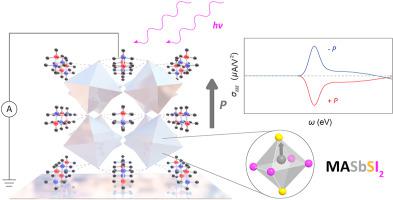Materials Today Physics ( IF 10.0 ) Pub Date : 2021-06-24 , DOI: 10.1016/j.mtphys.2021.100459 Min Zhao , Hua Wang , Gaoyang Gou , Xiangdong Ding , Jun Sun

|
Organic-inorganic halide perovskites composed of three-dimensional (3D) corner-sharing octahedral framework, represented by methylammonium lead iodide MAPbI3, have attracted extensive research interests owing to their superior photovoltaic (PV) performance. On the other hand, taking advantage of spontaneous ferroelectricity and the associated bulk photovoltaic effect (BPVE), ferroelectric (FE)-PV materials are able to generate zero-bias photocurrent and above band gap photovoltage, offering the great promise for improved power conversion efficiency. However, FE nature of perovskite MAPbI3 remains controversial. Alternatively, heteroanionic perovskite where the multiple anions of distinct sizes and valence states are in ordered arrangement, can create polar crystal structures with permanent electric polarization. In current work, we choose the experimentally reported perovskite methylammonium antimony sulfur diiodide MASbSI2 as a prototypical example, and demonstrate trans S/I anion order and the stable out-of-plane ferroelectricity nearly independent of molecular dipoles from organic MA cations can be obtained in such a 3D organic-inorganic heteroanionic perovskite by first-principles calculations. The cooperative interplay of MA orientation, octahedral rotation, cation polar displacement and S/I anion arrangement that govern the origin and magnitude of ferroelectricity within MASbSI2 have been thoroughly explored and well rationalized by our comprehensive first-principles calculations and electrostatic bond strength sum analysis. Especially, based on our electronic structure and nonlinear photo-current responses simulations, FE perovskite MASbSI2 with combination of stable out-of-plane ferroelectricity up to 17.9 μC/cm2, tunable semiconducting band gap, static Rashba effect and polarization controllable strong photocurrent responses within the visible light range, is demonstrated to be a long-sought 3D FE organic-inorganic perovskite material for efficient light-current conversion through BPVE.
中文翻译:

在具有自发面外铁电性的阴离子有序钙钛矿二碘化硫 MASbSI 2中出现体光伏效应
由以甲基铵碘化铅 MAPbI 3 为代表的三维(3D)角共享八面体骨架组成的有机-无机卤化物钙钛矿由于其优异的光伏(PV)性能而引起了广泛的研究兴趣。另一方面,利用自发铁电性和相关的体光伏效应 (BPVE),铁电 (FE)-PV 材料能够产生零偏置光电流和高于带隙的光电压,为提高功率转换效率提供了广阔的前景. 然而,钙钛矿 MAPbI 3 的有限元性质仍然存在争议。或者,具有不同尺寸和价态的多个阴离子有序排列的杂阴离子钙钛矿可以产生具有永久电极化的极性晶体结构。在目前的工作中,我们选择实验报道的钙钛矿甲基铵二碘化硫锑 MASbSI 2作为原型示例,并证明了反式通过第一性原理计算,可以在这种 3D 有机-无机杂阴离子钙钛矿中获得 S/I 阴离子顺序和稳定的面外铁电性,几乎独立于有机 MA 阳离子的分子偶极子。MASbSI 2内控制铁电起源和大小的 MA 取向、八面体旋转、阳离子极性位移和 S/I 阴离子排列的协同相互作用已通过我们全面的第一性原理计算和静电键强度总和分析得到彻底探索和合理化. 特别是,基于我们的电子结构和非线性光电流响应模拟,FE 钙钛矿 MASbSI 2结合了高达 17.9 μ C/cm的稳定面外铁电性 如图2所示,可见光范围内的可调半导体带隙、静态Rashba效应和偏振可控的强光电流响应被证明是一种长期寻求的3D FE有机-无机钙钛矿材料,用于通过BPVE进行有效的光电流转换。

































 京公网安备 11010802027423号
京公网安备 11010802027423号